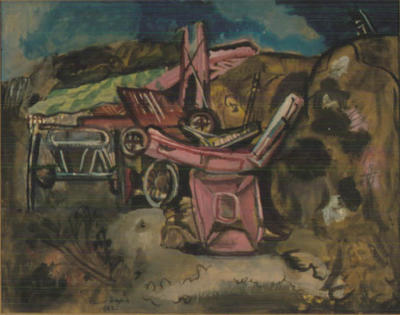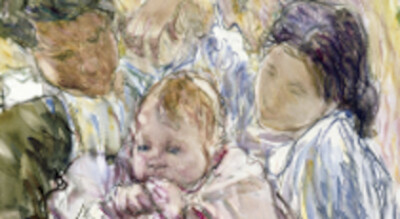The Red Elevator
Artist and role
Hodgkins, Frances Mary (New Zealand, b.1869, d.1947), Artist
Date
1942
See full details
About this work
Confined to England by the war and needing to produce work to meet her contract with her dealer, Frances found local subjects for painting in farms near where she lived. As in the 1920s she looked at the simple shapes of a tractor and its toy-like wheels; the textures of brick and stone walls; a grindstone sitting ready for sharpening tools; the jaunty verticals of ladders leaning against a hay rick; the shapes of trees and roofs and the general debris of a farmyard. Her works from this time have been seen as commentaries on the mechanistic destructiveness of war and they do have this aspect, but nonetheless she transforms everyday forms, colours and patterns into curiously joyful compositions, across every part of which the viewer’s eye travels with delight. In 1942 Frances Hodgkins began to be associated with British artists like Paul Nash, Graham Sutherland, Henry Moore and Matthew Smith whose work was often called neo-romantic – signifying nostalgia for a rural past and a fascination with ruins and rustic decay. Frances did see herself as working within the tradition of English landscape painting – and an inheritor of the struggles that all artists share. In 1942, after borrowing a book about Samuel Palmer (1805–1881), whose mystical and visionary landscapes she admired, she described him as ‘that massive & holy man. The more one reads of their private lives the more one sees the raw deal that is theirs from all but cradle to grave…'(1)
1. Letter to Eardley Knollys, 5 August 1944, Gill, p 552. The ‘private lives’ Frances refers to are those of Samuel Palmer and Camille Pissaro.
1. Letter to Eardley Knollys, 5 August 1944, Gill, p 552. The ‘private lives’ Frances refers to are those of Samuel Palmer and Camille Pissaro.
Measurements
435 x 563 mm sight size
Artist
Credit
Collection of the Dunedin Public Art Gallery. Purchased 1966 with funds from the Dunedin Public Art Gallery Society.
Accession number
9-1966


